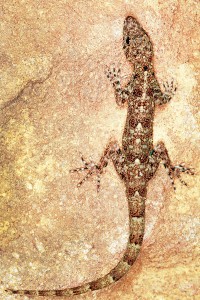News
A new huna emerges from unprotected Salgala forest
 Herpetologist Mendis Wickramasinghe who revealed a brightly-coloured new tree snake from the Sinharaja forest last week has now announced the discovery of a new endemic gecko, found in the Salgala forest in Kegalle district.
Herpetologist Mendis Wickramasinghe who revealed a brightly-coloured new tree snake from the Sinharaja forest last week has now announced the discovery of a new endemic gecko, found in the Salgala forest in Kegalle district.
The gecko, or huna in Sinhala, is a familiar creature: most of our houses are inhabited by a family of “house geckos” that mostly come out at dusk. The new gecko is different, being mostly active during the daytime. It prefers rocky habitats and is also smaller than the house gecko.
The researcher first found this Salgala gecko in 2012 while exploring the least explored areas of the country to fill in the gaps in knowledge on the reptiles and amphibians that live in those habitats. The research team found a healthy population of this gecko living in the wild around the Salgala area and also inhabiting outer walls of some of the houses close to the forest.
The new gecko is scientifically described as Cnemaspis rajakarunai, named in honour of Henry Rajakaruna, one of the masters of Sri Lankan photography, in recognition of his services to promote Fine Art Photography for over half a century. Mr.Rajakaruna perfected a technique of low shutter speed motion capture internationally known as “Rajakaruna style”.
In common language the Salgala gecko is called Rajakarunage diva huna, Rajakaruna pahalpalli and Rajakaruna’s day gecko in Sinhala, Tamil and in English, respectively.
Geckos are interesting creatures: they lack eyelids and have a transparent skin that they clean by licking. It also has a well-known defence mechanism of being able to lose its tail. While a predator is distracted by a still-alive detached tail, the gecko is able to hide in a safe place and, in time, grow a new tail.
Geckos move upside down on ceilings using specialised adhesive toe pads that enable them to climb smooth, vertical surfaces. Geckos shed their skin and, it is said, is able to replace each of their 100 teeth every three to four months.
The new discovery brings to 45 the number of gecko species in Sri Lanka. There are about 1,500 species worldwide.

Mendis Wickramasinghe
Salgala, where the new discovery was made, is a few kilometres away from Galapitamada, where the critically-endangered freshwater fish, bandula barb, has its sole habitat. Salgala is an unprotected forest patch, and that is of concern to researchers. Mr. Wickramasinghe said there was an urgent need to survey the unprotected ecosystems there since other new species awaiting discovery could perish if the habitat was destroyed.
Mr.Wickramasinghe’s work has been assisted by the Ministry of Environment, the Nagao Natural Environment Foundation and principal sponsor, Dilmah Conservation. Dulan Vidanapathirana and Gayan Rathnayake helped him with the research.

Rajakarunage diva huna

